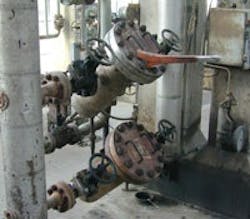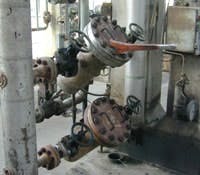Reliability and Maintenance: Don’t Slight Strainers
Strainers remove relatively large diameter particulates — typically 325 µ (0.00128-in.) or larger — from process streams by screening the solids out with either a plate element or wire mesh. Getting rid of smaller particles normally requires a filter.
[pullquote]
Strainers may have temporary or permanent installations. Temporary strainers remove maintenance or construction debris on startup. Typically they stay in service for a week after startup. Permanent strainers remain in the process to cope with ongoing issues with solids or extreme sensitivity of equipment. Examples of services using permanent strainers include water suction from open-air sources, catalyst fines’ removal from process streams and protection of downstream operations from piping system corrosion products. In a piping system, it’s often logical to install the strainer where pipe materials change.
Figure 1. Permanent strainers often are installed in pairs so one always is in service.
Plate strainers use a simple element inserted between pipe flanges. The flat plate either has drilled or punched holes or a wire screen. In recent years, some manufacturers have switched to laser cutting. The laser cutter can produce any diameter hole or slot; it’s not limited to standard drill or punch sizes and shapes. Plate strainers mostly are for startup to remove occasional chunks of debris. They have relatively low open areas and are restricted to the pipe cross-sectional area, which limits their removal capability. Adding a wire mesh screen reduces the open area even more. Moreover, it generally has a relatively high pressure drop and low capacity to hold bulk material. (For information on wire mesh, see “Tailor Your Wire Cloth.")Specifications for plate strainer elements normally set a hole size, hole open area (or percent) and required mechanical strength.
Increasing the strainer capacity requires shifting to a Y-strainer or basket strainer. The common Y-strainer allows for compact installation. Y-strainers typically are set by the line size. The simplex basket strainer comes in nearly endless varieties.
Figure 1 shows two basket strainers installed in a process plant. Some particular points merit attention:
• The strainers are installed in parallel; one should be in service at all times.
• Single isolation valves enable removing the strainers from service.
• No integral davits are included to hold the strainer lids.
• The strainers are angled to ease access and reduce piping-layout clearances.
• Hard-piped connections allow for draining on the true body low-point.
• Instrumentation monitors pressure drop across the strainers.
When a strainer plugs, how to clean it depends upon plant configuration. If there’s no bypass, the unit must be shut down. With one strainer and a bypass, the plant can continue to run while the strainer is cleaned. In critical applications, a second strainer in parallel provides for keeping a strainer in service at all times. The choice depends upon the type of unit that’s being strained. If the plant shuts down weekly for product changes but the strainer only needs monthly cleaning, extra strainers and piping may not be necessary. If passing particulates for short periods is only a minor problem, a bypass alone may suffice. For critical services, the second strainer is necessary.
Cleaning requires opening the process. As noted, the strainers in Figure 1 use single isolation valves. Isolation requirements depend upon the fluids and operating conditions, and must consider safety.
Lift-off flange heads may suffice for small strainers such as those pictured. However, strongly consider an integral davit to hold the head of a larger strainer — it will speed basket changes and make the job simpler and, thus, foster better maintenance practices.
Angling the strainer reduces the vertical height required for installation and for removing and replacing the basket. (This may not be crucial in initial plant construction but may come in handy when adding strainers later.) A modest angle is acceptable.
Note that the drain connection on each of the strainers shown is on the true low-point of the strainer body; this prevents accumulation of a small pocket of liquid. Hard-piped connections are useful because they make draining easier and reduce the chance of spills.
The typical strainer should be cleaned at 1–2-psi pressure drop. Basket strength usually will suffice for a 10-psi pressure drop. However, I routinely specify a 15-psi mechanical requirement. The installation shown in Figure 1 has differential pressure connections, although they are hard to see, so the control room can monitor the pressure drop across the strainers. If the operators don’t know the pressure drop, the strainers often won’t get changed. A broken strainer carrying both the solids and basket fragments downstream helps nobody. At a minimum, all strainer installations should include connections for pressure drop measurement —frequently they deserve full pressure-drop instrumentation.
Strainers, although often overlooked, provide many processes with critical stream cleanup to meet process requirements and protect equipment. Installation that makes strainers easier to track, and simpler and safer to change can optimize their performance.
ANDREW SLOLEY is a Chemical Processing Contributing Editor. You can e-mail him at [email protected]

